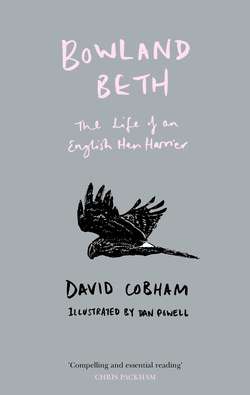Читать книгу Bowland Beth: The Life of an English Hen Harrier - David Cobham - Страница 6
Оглавление
Bowland Beth, named after the Forest of Bowland where she was bred, was an exceptional hen harrier. Some harriers, when near to fledging, stand head and shoulders above the rest of the brood. They are bigger, their plumage is glossier and richer in colour, their eyes are brighter and they fledge ahead of their siblings. Beth was one such.
Following the style of Henry Williamson’s Tarka the Otter and Fred Bodsworth’s Last of the Curlews, I have dramatised Beth’s short life between 2011 and 2012, trying to enter her world to show what being a hen harrier today is like. I have immersed myself not only in the day-to-day regimen of her life – the hours of hunting, bathing, keeping her plumage in order and roosting – but have also attempted to express the fear of living in an environment managed to provide packs and packs of driven grouse for a few wealthy people to shoot for sport.
I hope that by dramatising Bowland Beth’s life I can rally another group of conservationists to join other groups already working hard to challenge those who are determined to illegally exterminate English hen harriers in the interests of driven grouse shooting.
Nearly fifty years ago I made a film of Tarka the Otter, and when it was finished we held a special press show for children, mostly teenagers. Afterwards I asked the audience to come forward and ask questions. Mostly they wanted to know how we made the bubbles and blood in the river. Finally, I was left with one teenaged girl standing before me. When I asked her whether she had liked the film, she said: ‘The otter died. It made me cry.’ To her astonishment I replied: ‘That’s wonderful. You felt something.’
I’m often told that my film of Tarka played an important role in getting otter hunting banned in England and Wales in 1980. Can this dramatised version of Beth’s life awaken similar emotions in people’s hearts and compel them to stand up and deplore in the strongest terms the illegal persecution of the few remaining breeding hen harriers in England? I hope so.
I have been able to dramatise Beth’s life because she was fitted with a satellite tag, and the moment she fledged she was tracked as she sped off to a grouse moor at Nidderdale thirty miles away. A select few watched with delight and alarm as she foraged over a wider and wider area. She survived the winter, and in late spring her hormones kicked in and she started searching high and low for a mate. Her journeys up into the wilds of Scotland made her a national celebrity. On one journey north she covered 125 miles in just eight and a half hours, but without fail she returned to where she had been fledged in the Forest of Bowland.
I knew about the Forest of Bowland because my wife Liza had visited it whenever she could when she was performing in plays at the Grand Theatre in Blackpool. Each time she came back she was bubbling over at the number of harriers she had seen and how kind Stephen Murphy, Natural England’s hen harrier project officer in Bowland, had been in showing her round.
Now, on 24 May 2012, I was going to see Bowland myself. I was researching for a book I was writing on the state of our birds of prey in Britain today and my companion was Eddie Anderson, whom I had known for nearly fifty years. When I first met him he was a gamekeeper. Eventually, after seven years, he gave up gamekeeping and forged a fine career making programmes for Anglia TV and BBC East.
We travelled by train from Norfolk. At Clitheroe, our destination, we were met by the late Mick Carroll, one of Stephen Murphy’s most dependable hen harrier watchers. He was going to drive us around Bowland, so we got into his car and he whisked us off to The Hark to Bounty pub in Slaidburn, where we were booked in for two nights.
We had a brief meeting with Stephen Murphy after breakfast. He promised to show us around the following day and then handed us over to Bill Hesketh and Bill Murphy, Stephen’s local, highly regarded harrier watchers. The rain had cleared, and the fells and moorland sparkled like a newly minted coin.
The rolling hills were dominated by a patchwork of green sprouting heather set against lower areas of grass split up into tiny fields by fences and stone walls, and I could quite understand why the place had been named an Area of Outstanding Natural Beauty, a European designation that recognises the importance of its heather moorland and blanket bog as a special habitat for upland birds.
The wild, desolate landscape is an excellent location for bird watching. Curlew, golden plover, oystercatchers and snipe are all found here, and migrating dotterel pass through in spring and autumn. The summer population of breeding curlew is one of the most buoyant in England, and short-eared owls can regularly be seen hunting in daylight for their favourite prey, short-tailed field voles.
Three important birds of prey breed in the Forest of Bowland: the merlin, our smallest bird of prey and not much bigger than a mistle thrush, the much larger peregrine falcon, which, with its 200 mph scything stoop, has been described as the most successful bird in the world, and the hen harrier. The hen harrier is the symbol of the Forest of Bowland and used to be seen regularly as it floated low over moorland hunting for small birds and field voles.
